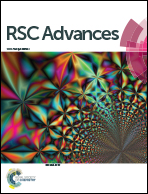Surface functionalization of natural lignin isolated from Aloe barbadensis Miller biomass by atom transfer radical polymerization for enhanced anticancer efficacy†
Abstract
Lignin (LIG), one of the major natural polymers in the biomass is widely used for various industrial and biomedical applications, mainly in its modified form of grafted lignin. The present study focuses on the isolation of lignin from Aloe barbadensis Miller by a microwave extraction technique and its applicability as a medicinal biomass. The isolated lignin was used for the synthesis of a drug carrier by grafting with methacrylate (MA). Lignin grafted methacrylate was synthesised (LIG-g-MA) via atom transfer radical polymerization (ATRP). 5-Fluorouracil (5-FU) was used as a model cancer drug and it was encapsulated on the hollow nanocarrier by the emulsion/solvent evaporation technique. While NMR spectroscopy elucidates the structure of the isolated lignin, FT-IR and XRD techniques address the binding nature and crystalline character of 5-FU loaded carrier. The surface morphology of the isolated lignin, grafted lignin and drug-loaded carrier was confirmed with SEM and TEM techniques. The encapsulation efficiency and in vitro drug release were studied to determine the efficiency of the carrier. The cell viability and cytotoxicity effect of 5-FU loaded on LIG-g-MA and unloaded LIG-g-MA were performed against MCF-7 and VERO cell lines. In short, the modified natural lignin based on LIG-g-MA hollow-nanofibrous material has been shown to be a potentially useful biocompatible nanocarrier in chemotherapy for cancer treatment.


 Please wait while we load your content...
Please wait while we load your content...